Feature Publication Archive
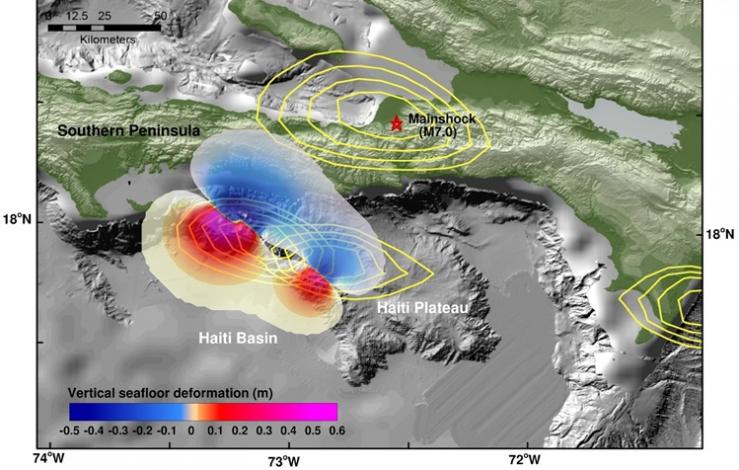
Tsunami finite-fault model for the dynamically-triggered early aftershocks of the 2010 M7.0 Haiti earthquake. Colors denote vertical seafloor deformation from the tsunami source model. Yellow contours are the peak back-projected energy contours of the main shock and the three early aftershocks. Red star is the epicenter of the 2010 Haiti earthquake. The DART buoy D42407 is positioned about 600 km southeast of the epicenter of the main shock in the Caribbean Sea.
ten Brink, U., Y. Wei (UW-CICOES/OAR-PMEL), W. Fan, J.-L. Granja-Bruña, and N. Miller, 2020: Mysterious tsunami in the Caribbean Sea following the 2010 Haiti earthquake possibly generated by dynamically triggered early aftershocks. Earth and Planetary Science Letters, 540, 116269. https://doi.org/10.1016/j.epsl.2020.116269.
The magnitude 7.0 Haiti earthquake of 2010 ruptured a complex fault network including both strike-slip faults (where two blocks slide past one another) and reverse faults (in which the upper block, above the fault plane, moves up and over the lower block). The earthquake affected the region spanning from the northern side of Haiti’s Southern Peninsula on land to an area off the north shore of the peninsula. The offshore rupture produced a minor tsunami that impacted the north shore of the Southern Peninsula.
Intriguingly, a much more prominent tsunami was also reported with up to 3... more »

Dungeness crab larvae (a) and magnified segment of its damaged shell (b) from Bednaršek et al. (2020).
Bednaršek, N., R.A. Feely, M.W. Beck, S.R. Alin, S.A. Siedlecki, P. Calosi, E.L. Norton, C. Saenger, J. Štrus, D. Greeley, N.P. Nezlin, and J.I. Spicer (2020): Exoskeleton dissolution with mechanoreceptor damage in larval Dungeness crab related to severity of present-day ocean acidification vertical gradients. Sci. Total Environ., 716, 136610. https://doi.org/10.1016/j.scitotenv.2020.136610
With annual revenues up to $220 million, the Dungeness crab (Metacarcinus magister) is one of the most valuable commercial fisheries on the US West Coast. Yet, rapid intensification of ocean acidification (OA) along the US West Coast is reducing natural habitats of crabs by increasing corrosiveness of the water due to the uptake of human-generated CO2. The steady increase in seawater CO2 can trigger multiple impacts that are most significant in the upper water column that is inhabited by Dungeness crab larvae, one of the most vulnerable life stages of the 4-year long life cycle of... more »
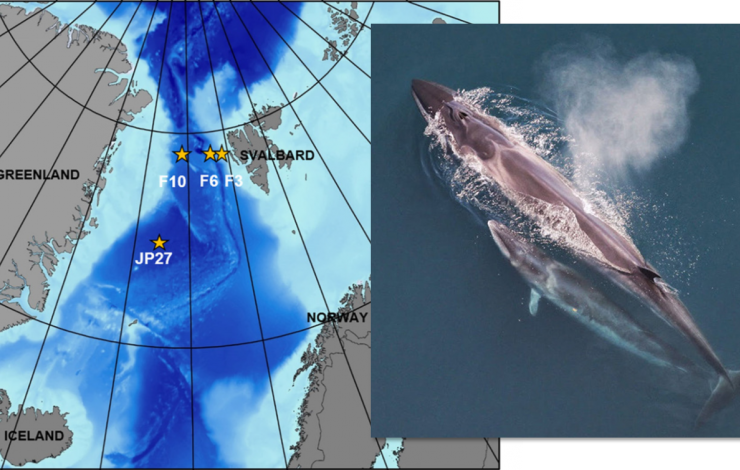
Stars show locations where sei whales, similar to this mother and calf, were detected.
Nieukirk, S.L., D.K. Mellinger, R.P. Dziak, H. Matsumoto, and H. Klinck (2020): Multi-year occurrence of sei whale calls in North Atlantic polar waters. J. Acoust. Soc. Am., 147(3), 1842–1850. https://doi.org/10.1121/10.0000931
The sei whale is a large baleen whale, in the same genus as the blue whale, found in most of the world's oceans outside the Arctic. From 2009 to 2014, we searched acoustically for sei whales off the northeast coast of Greenland on the edge of the Arctic Ocean. We did this by deploying hydrophones (underwater microphones) and recording ambient sound, then searching the resulting recordings for calls of sei whales. We heard many sei whale calls every summer in regions 600 km (400 mi) north of where they were known to routinely occur. We do not know if these detections surprisingly far north... more »
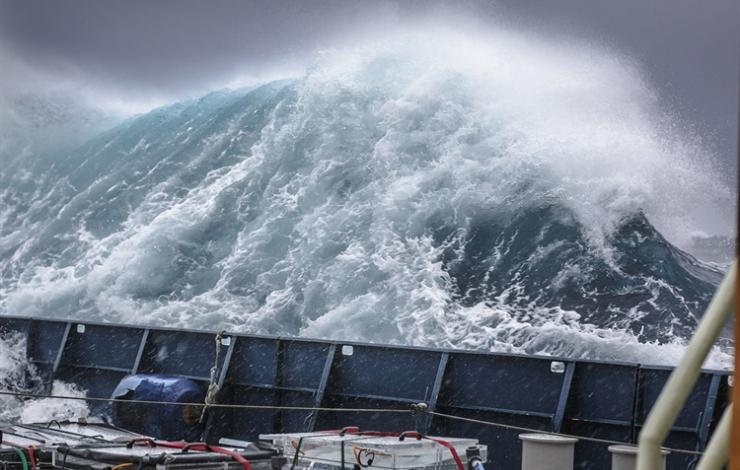
,November storm in the western North Atlantic during the first North Atlantic Aerosols and Marine Ecosystem Cruise. Photo credit: Christien Laber
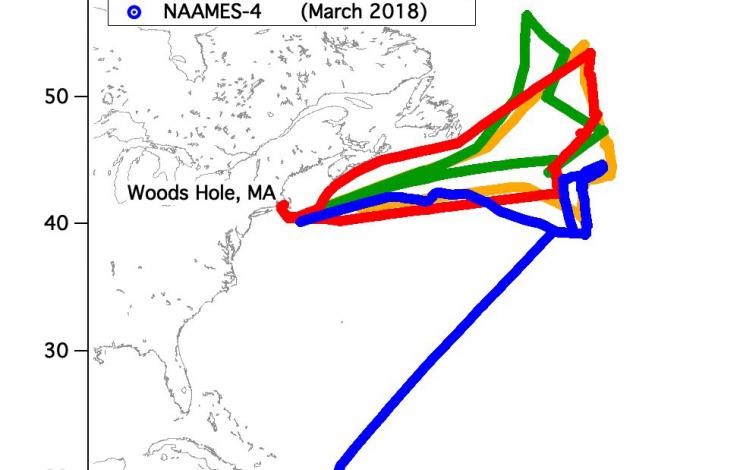
NAAMES research cruise tracks & timing.
Quinn, P.K., T.S. Bates, D.J. Coffman, L. Upchurch, J.E. Johnson, R. Moore, L. Ziemba, T.G. Bell, E.S. Saltzman, J. Graff, and M.J. Behrenfeld (2019): Seasonal variations in western North Atlantic remote marine aerosol properties. J. Geophys. Res. Atmos., 124(24), 14,240–14,261. doi: 10.1029/2019JD031740
Wave-breaking at the ocean surface transports pockets of air from the atmosphere into the upper few meters of the ocean. This air forms bubbles and as these bubbles rise to the ocean surface they pick up organic compounds associated with ocean biological activity. When the bubbles burst at the surface they release atmospheric aerosols containing those organics plus inorganic sea salt. In addition, dimethylsulfide (DMS), derived from phytoplankton, is transferred from the ocean to the atmosphere. Once in the atmosphere, it is oxidized to form sulfate aerosol. Ocean-derived organics and... more »
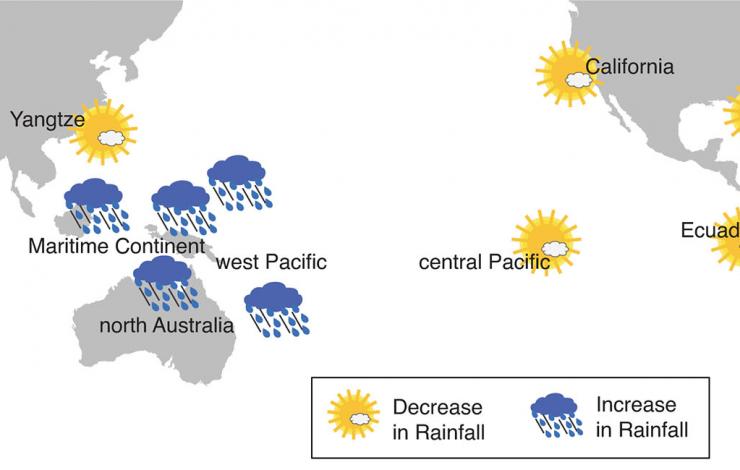
Rainfall changes due to warming of the Indo-Pacific Ocean and corresponding changes in the Madden Julian Oscillation. The shining sun depicts areas of declining rainfall while the rain clouds show where rainfall is increasing. Credit: Roxy M. Koll, Indian Institute of Tropical Meteorology, et al., Nature
Roxy, M.K., P. Dasgupta, M.J. McPhaden, T. Suematsu, C. Zhang, and D. Kim, 2019: Twofold expansion of the Indo-Pacific warm pool warps the MJO life cycle. Nature, 575, 647-651. https://doi.org/10.1038/s41586-019-1764-4
A new study published in the journal Nature (Roxy et al., 2019) shows that warming of the Indo-Pacific Ocean is altering rainfall patterns across the globe, contributing to declines in rainfall along the U.S. West Coast and parts of the East Coast. The research, involving NOAA scientists and others from India, Japan, and the U.S., reports that the warm pool of water spanning the western Pacific and eastern Indian Ocean has doubled in size over the past century. This “Indo-Pacific warm pool”, which is already the warmest part of the global ocean, is expanding each year by an area the size... more »


